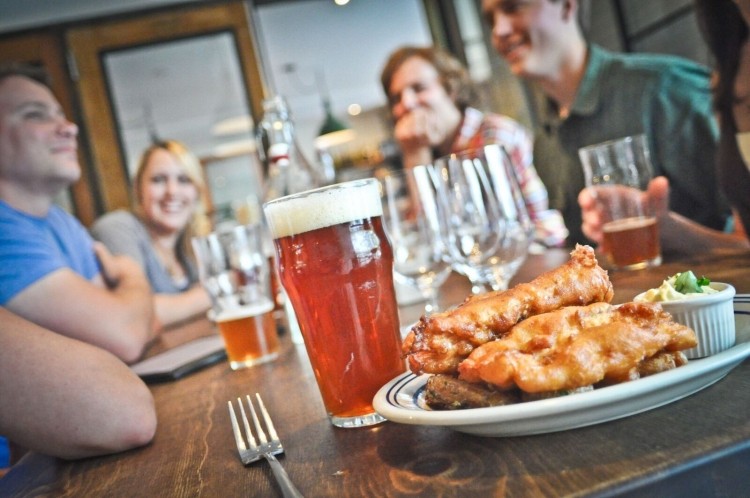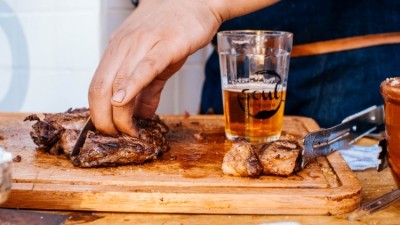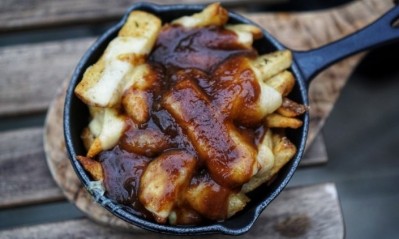Finding the perfect match: How pubs can drive revenue by elevating their beer and food offering

In many ways, beer is a more natural pairing for food than wine. The breadth and variety of flavours produced from the grain far exceeds those encountered from the grape, and the higher levels of carbonation present in beer are a much more efficient palate cleanser than most wine. Being made from grain that is already kilned, beer even smells like cooked food, and it is rare to find a dish than cannot be improved with an appropriate beer at its side.
However, for many years, pubs and restaurants were content to simply plonk a bottle of wine on the table alongside a meal, owing partly due to the higher margin and lower labour costs it commands (no dashing to and from the table carrying multiple bottles and fresh glassware). However, with the decline of wet-led pubs and the increasing proliferation of great beer, operators are starting to wake up to the opportunities the range of flavours, aromas and textures beer can present alongside food.
“In America, the majority of on trade establishments offer an extensive beer list alongside menu suggestions and the vast diversity of different beer styles lend themselves perfectly to food matching,” says Adam Dulye, Executive Chef at The Brewers Association. “With the groundswell of interest in craft beer and the wide range of styles available in the UK, the time is now ripe for pubs to move away from the ‘pint and pie’ mentality and explore the wealth of opportunities available for beer and food.”
Rules to be observed
Somewhat unfortunately, there is no equivalent to the “red wine with meat, white wine with fish” rule as far as beer is concerned. However, there are a few rules that pubs can employ to help elevate their food and beer offering. The Brewers Association (BA) recommends stocking 4-5 different beer styles to suit the types of dishes on offer, whilst regularly rotating individual products to maintain customer interest.
“There are three main interactions with beer and food pairings,” Dulye says. “Complementing, contrasting and cutting. For a dish to be complementary you’re looking for harmonious flavours between the ingredients and the craft beer e.g. roast duck breast with a brown ale or Dubbel or the light acidity of a witbier with a salad and vinaigrette dressing.
“Contrasting is the most challenging interaction on the palate and works best when the dominant flavour of the dish contrasts against the main flavour profile of the beer e.g. sweet vs sour or bitter vs sweet. A classic example is the tropical flavour notes of an American IPA with an intensely, hot pepper spiced dish or curry.”
“Craft beer cuts through the fat of rich, succulent and creamy foods to cleanse the palate after every mouthful and leave it feeling refreshed, clean and ready for the next bite,” Dulye adds. “The bitter strength and astringency of hops lifts fat from the palate and a sweet finish cuts away acidic flavours, leaving a pleasant sensation in the mouth.”
Once you’ve mastered the basics of matching your menu with beer (see our helpful guide below), operators may want to consider hosting a beer dinner or beer and cheese pairing evening to boost sales. These events are a great way to experience beer and food together, and can be themed around a particular country’s beer offering or cuisine. Like any gastronomic experience, the setting and preparation are key in ensuring this type of event is a success.
There’s A Beer For That, a campaign backed by Britain's Beer Alliance and aimed at promoting food and beer pairing in the UK, helps pubs to put on beer and food pairing evenings under their Beer Club Live banner. The organisation provides point of sale merchandise and practical advice for pubs on how to structure their evening to ensure maximum customer satisfaction.
The Brewers Association’s top tips to promote beer and food pairing
- Match strength with strength. Pair delicate dishes with lighter craft beers and strongly flavoured dishes with intense, more assertive beer styles.
- Ensure your staff can talk knowledgeably about beer styles and flavours using vocabulary everyone understands. Skilful upselling of beer can lead to greater sales because customers are likely to have more than one.
- Always serve craft beer in custom-shaped glass appropriate to the beer style to allow the optimum delivery of aroma on the nose and balance of flavour on the palate.
- Bottled and canned beers are not always visible to the diner and they may not know they are available. Ensure you describe your beer range on the menu and include tasting notes and pairing suggestions.
- Consider stocking a corked and caged 750ml sharing bottle that can be sold at a premium
Transformative power
“Licensees can improve their beer and food pairings by getting staff involved and by providing them with a basic education that they can then share with customers,” says David Cunningham, There's A Beer For That’s Programme Director. “There are lots of Beer Sommeliers who can provide staff training and by making it fun, interactive and experimental they can also help improve staff morale, development and retention.
“Alternatively, keep it in-house and ask each member of staff to pick a dish from the menu and a couple of beers to pair with it. Not all the matches will work, but the ones that do will stick in their minds and can be added to the menus. Promote the pairings on menus and point of sale to raise awareness; you might even add a personal touch by mentioning the name of the team who recommends that match.”
For a beer dinner, There’s Beer For That suggests serving 4-5 courses matched with 5-6 beers measured as a third of a pint or served in a small glass. Ticketing the event will give operators complete control over event logistics and allows them to order in the correct quantities of food and drink, whilst having a knowledgeable event host to guide attendees through proceedings will make them feel like they are getting good value for money.
“For licensees who don’t want to go with a full five-course beer and food themed dinner, or don’t have the catering facilities available to do so, we’d recommend keeping it simple,” Cunningham adds. “Beer and cheese pair beautifully together and can be an excellent introduction to the art of matching.
“Easy to prepare and simple to match, a beer and cheese evening is straightforward to organise and is a real discovery for customers. We have a pocket guide for pairing beer and cheese and can provide all the information needed for hosting a successful event.”
Getting people to accept beer and food together remains a challenge, but the right beer paired with the right dish can be a transformative thing with the power to enhance any pub-going experience. It’s time to put down that wine list and get educating.
Getting it right: Which beer style with which dish?
IPA: Probably the most famous beer style in the world, India Pale Ale (IPA) is characterised by high levels of alcohol and hops. It gained its name thanks to huge popularity in the British Empire throughout the 19th century, as a result of its keeping ability on long sea voyages and its refreshing character upon reaching its final destination. Try matching an IPA with a rich, creamy cheese such as Gogonzola, where the sharp bitterness will cut through the cheese, or with a moderately spicy curry like Tikka Masala. For dessert, try pairing a tropical and citrusy IPA with a sharp lime pie.
Smoked Beer: Smoked beers are created with the addition of malt dried or kilned using smokey fuel such as juniper, beech wood or peat. Any beer can have smoked malts added to it, although the German style of Rauchbier is probably the most commonly known example. These lagers have a distinctly bacon-like flavour created by the use of beech logs in the malt-kilning process. Smoked beers are a great accompaniment to barbequed food, roasted meat, and grilled vegetables. They are also a natural pairing for cheeses such as Lincolnshire Poacher or any smoked cheddar.
Suggested beer match: Anspach & Hobday The Smoked Brown
The Smoked Brown is inspired by the era when malted barley was kilned over fire giving the beers of Britain a Smokey character. This modern tribute uses Rauch-malt fired over beechwood in Bamberg, Germany – home to Rauchbier. Aged on oak this complex brown ale is the perfect accompaniment for Strong Cheese and meats.
Fruit Beer: A style derived from the Belgian tradition of lambic-production. Fruit beers are fermented using a variety of fruits including cherries, raspberries and peaches, although many non-traditional and modern varieties are typically artificially sweetened and based on syrups instead of whole fruit. Some fruit beers can be sickly in large quantities, but are often a good way to entice non-beer drinkers into the category. Pair a fruit beer with a creamy dessert such as cheesecake, crème brulee or ice cream to cut through the richness and avoid cloying.
Porter: A dark style of beer developed from well-hopped beers made from brown malt, porter is synonymous with London brewing culture, where the high termporary hardness of the water was historically well suited to brewing the style. Porter works particularly well with charred or barbequed meats, highlighting the roasted character and bringing out what is known as the Maillard reaction (a chemical reaction between amino acids and reducing sugars that produce a searing flavour). You could also try porter as an alternative to port when serving mellow blue cheese or stilton
Lager/Pilsner: This style originates in 19th century Bohemia, with modern variations including pilsner, helles and bock. It is often brewed in Germany or the Czech Republic. It's made with a bottom fermenting yeast then conditioned at a low temperature and is usually heavily carbonated. With food, it is best to pair lager with grain based dishes such as a creamy risotto. The complementary grain flavours will balance the hops while remaining light on the palate. Alternatively, try it with a light meat such as chicken; the crisp drink will cut through the meat and cleanse the palate between mouthfuls.
Suggested beer match: Carlsberg Export
Carlsberg is proud of its talented brewers and the great beer it produces. This premium pilsner is top of the class. The brewer will start to share more of its unique Danish identity with consumers. In 2017, Expørt will be relaunched – with a new distinctly ‘Danish-inspired’ makeover – celebrating its Danish provenance.
Wheat Beer: One of Germany’s most distinctive and famous styles, the weissbier is a light and zesty beer produced with at least 50% malted wheat. Sometimes known outside of Bavaria as a hefeweisen, it is similar to but not to be confused with Belgian Witbier, which is usually spiced with herbs such as coriander, orange and orange. Pair weissbier with seafood dishes, fish and sushi to balance out the salt and acidity, whilst adding richness to the beer. It also works well with light summer salads and simple milky cheese like mozzarella.
Stout: Stout is a dark beer made using roasted malt or roasted barley. There are a number of variations including Baltic porter, milk stout, and imperial stout; the most common variation is dry stout such as Guinness. The dark and roasty notes of a stout pairs well with hearty, rich foods such as steak, meat pies, casseroles, chocolate and oysters. Alternatively, drinking stouts with carrots, peppers and mushrooms will bring out the umami in the vegetables and balance out the sweetness. As a desert pairing, a sweet imperial stout will work excellently with brownies or a Chrismas pudding.
Saison: Originally produced in Belgium and consumed by migrant workers during harvesting season, saison has evolved into a highly carbonated, fruity and spicy style of beer, often produced with the addition of spices such as orange zest, coriander, and ginger. Certain strains of saison yeast can also produce funky, barnyard-like esters. The style is a natural pairing for shellfish dishes such as mussels, where the dry and effervescent profile brings out the salinity of the fish. Spicier saisons work well with Thai cuisine, whilst wild-yeast variations are a great match for funky cheeses like Taleggio or Brie.
Suggested beer match: Burning Sky Saison A La Provision
Burning Sky’s Saison A La Provision is brewed in homage to the old style 'keeping' saisons of Wallonia. Aged for 3 months in oak vats with wild yeast strains, the result is tart with a crisp acidity. Very refreshing, this beer will also appeal to lovers of natural wine and real ciders. Burning Sky recommends pairing Saison A La Provision with sea food dishes.
Best Bitter: British pubs have been using the term bitter to describe pale beers since the early 19th century to avoid accidently ordering a sweeter, less hopped mild. The modern best bitter ranges from 4-5 % ABV and is made from Marris Otter and small amounts of crystal malt. They are hopped with moderately bitter English hops such as Goldings and Fuggles. Bitter goes with a wide range of foods due to its inoffensive hop character and comforting malty flavours. Try it with roasted meat such as chicken, pork or duck, or with a classic English dish such as fish and chips.
Sour Beer: Technically a flavour descriptor and not a style, sour beers get their sharp acidity profile either from fermentation by wild yeast strains, or through a process known as kettle souring, where the pH of the wort is artificially lowered prior to boiling. Whilst traditionally a Belgian style, sour beer is now hugely popular with craft breweries and is terrific with food. Try a traditional lambic with a tangy rind washed cheese like Brie or Gruyère, or pair a salty gose with mussels. Alternatively, most sours will work alongside rich chocolate, creamy desserts to provide contrast and cut through the fat e.g. a Black Forest gateau.
Suggested beer match: Siren Calypso
Calypso, the Goddess known for her sharp tongue . This beer is a homage to this enchantress, a tart, spritzy Berliner-style sour beer that is liberally dry hopped with a different hops for each batch. Calypso cuts through fatty foods particularly well and also pairs well with fish, making it an ideal companion to fish and chips.
Red Ale: Amber-to-red coloured ales tend to be similar to pale ales, but with a larger quantity of medium-to-dark caramel or crystal malts, which provide a notable caramel to toffee flavour and a perception of malt sweetness in the palate. They are typically made using American hops, which add a piney aroma and moderate bitterness. Red ales are particularly versatile, and can be drunk with a variety of foods such as chicken, seafood and burgers. They also pair well with spicy food such as chilli and curry, where the hop bitterness and caramel sweetness balance out the heat of the dish nicely.
Pale Ale: A hugely versatile style of beer, pale ale refers to the broad category of beers produced using predominantly pale malts. The style has become hugely popular amongst craft brewers, who use large quantities of American hops to produce light, citrusy and fruity beers. Pale ale can be paired with a wide range of different foods, but works especially well with dishes such as burgers and pizzas, and cheeses like Brie, Gouda, Aged Cheddar and Mozzarella. It complements the natural flavous and textures present in the cheese, whilst cutting through the fat and cleansing the palate.
Suggested beer match: Marston's 61 Deep
61 metres – that’s the depth of the brewery well that gives this refreshing pale ale its name. Its five American and Australian hops give it its fresh zesty aroma, while the tropical fruit and citrus notes make it extremely drinkable. Dive in. Pair with spicy chilli, Mexican foods and desserts such as lemon torte.







